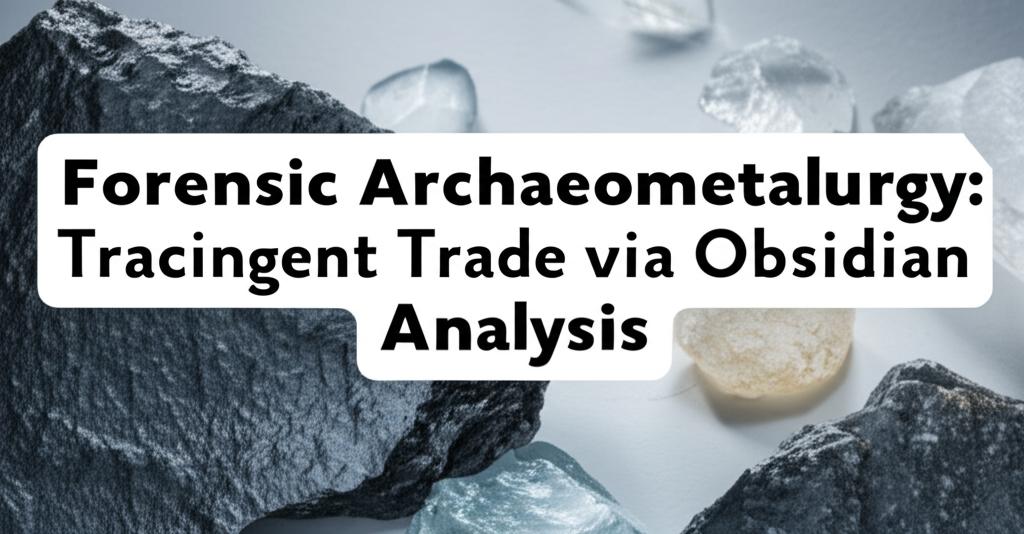Obsidian, a naturally occurring volcanic glass, was a highly prized material in antiquity, used for tools, weaponry, and ceremonial objects due to its sharpness and aesthetic qualities. The practice of sourcing obsidian artifacts back to their original volcanic origins is a cornerstone of archaeometallurgy, offering profound insights into ancient trade networks, cultural interactions, and technological advancements. By analyzing the unique chemical "fingerprint" of obsidian, researchers can map the movement of this valuable commodity across vast distances, illuminating complex economic and social systems of past civilizations.
Recent research continues to refine and expand our understanding of these ancient connections. For instance, a significant study on obsidian found at the Templo Mayor in Tenochtitlan, the capital of the Mexica (Aztec) Empire, has revealed the intricacies of their economic networks. This research, the largest compositional study of obsidian at the site, analyzed 788 artifacts. While the Mexica predominantly utilized green obsidian from the Sierra de Pachuca source, valued for its distinctive color and symbolic associations, they also acquired obsidian from at least seven other locations. Some of these sources were situated beyond their political borders, indicating sophisticated long-distance trade relationships, even with rival polities. The diversity of obsidian types, particularly for non-ritual items, suggests that market systems, rather than solely direct acquisition or conquest, played a crucial role in supplying the imperial capital. This highlights a complex economy reliant on both tribute and active trade. The study also tracked changes in obsidian use over time, noting that as the empire consolidated power, obsidian for ritual purposes became almost exclusively sourced from Sierra de Pachuca, suggesting increasing religious standardization and centralized control.
The methods for sourcing obsidian have evolved significantly since early visual identification. Today, geochemical analysis is the primary approach, examining the unique trace element composition of obsidian to match artifacts to their geological sources. Techniques like X-ray fluorescence (XRF) are widely employed, particularly portable XRF (pXRF) systems, which allow for non-destructive analysis of artifacts in the field or in museum collections. This has made it easier to analyze large assemblages, including small debitage (waste flakes from tool production), leading to the identification of rare or "exotic" obsidian sources not commonly found. Other methods include Neutron Activation Analysis (NAA) and Laser Ablation-Inductively Coupled Plasma-Mass Spectrometry (LA-ICP-MS), which can provide highly accurate sourcing but may sometimes require destructive sampling of a small part of the artifact.
These analytical techniques have been applied globally, revealing extensive obsidian trade networks. In Mesoamerica, beyond the Aztec studies, research has illuminated trade routes used by the ancient Maya, showing shifts in preferred sources over time and the complex interplay of overland and sea routes. For example, studies have explored the distribution of obsidian from sources like El Chayal, Ixtepeque, and San Martin Jilotepeque, and even identified material from as far as La Esperanza.
Similarly, in North America, recent investigations in Alberta, Canada, where no native obsidian sources exist, have demonstrated the vast reach of Indigenous trade networks. Analysis of obsidian artifacts, some dating back 13,000 years, has traced their origins to sources as far as 750 to 1,200 kilometers away, primarily from locations like Bear Gulch in Idaho and Obsidian Cliff in Wyoming. This research suggests that communal bison hunting in southern Alberta may have facilitated these extensive trade connections, while distinct northern routes utilized major river systems. The sheer scale of this trade implies contact and interaction between millions of people across a massive geographical area.
In the Mediterranean, obsidian sourcing has been instrumental in understanding Neolithic trade for decades. Early seminal work by Cann and Renfrew established the potential of trace-element analysis to identify obsidian sources and reconstruct trade patterns. More recent and comprehensive studies, analyzing large numbers of artifacts from islands like Sardinia and Corsica, have refined these models. By identifying specific subsources within larger volcanic regions like Monte Arci in Sardinia, researchers can study differential exploitation patterns based on factors like accessibility, nodule quality, and visual properties. This detailed analysis supports models like "down-the-line" trade, where goods are exchanged from group to group over distances, and helps address broader questions about island colonization, the spread of Neolithic economies, and emerging social complexity. Evidence from the Near East also highlights long-distance connections, with obsidian from Anatolian sources found in Chalcolithic sites in Israel.
The ongoing advancements in analytical techniques and the increasing number of comprehensive studies worldwide continue to push the boundaries of forensic archaeometallurgy. The ability to precisely source obsidian artifacts provides an invaluable window into the dynamic HSRF.human past, revealing the complex tapestry of trade, migration, and cultural exchange that shaped ancient societies. This research not only reconstructs economic systems but also sheds light on political influence, ritual practices, and the social dynamics of resource control and distribution.

